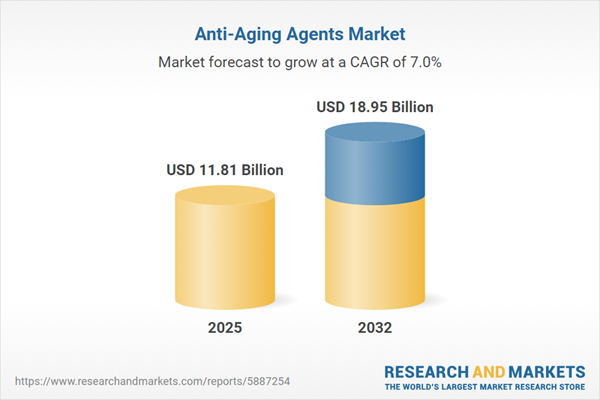Speak directly to the analyst to clarify any post sales queries you may have.
The anti-aging agents market is experiencing significant transformation, fueled by shifting self-care priorities, evolving consumer expectations, and rapid technology adoption. Senior decision-makers must proactively navigate this changing environment to maintain competitiveness and harness new avenues for sustainable growth.
Market Snapshot: Anti-Aging Agents Market Growth and Outlook
The global anti-aging agents market stands at USD 11.02 billion and is projected to reach USD 18.95 billion by 2032, advancing with an anticipated compound annual growth rate (CAGR) of 7%. This trajectory is driven by rising health awareness, greater scrutiny toward ingredients, and a strong movement toward holistic wellness. As competition intensifies and regulatory expectations evolve, top companies are responding with targeted differentiation and strategic innovation. Supply chain agility, coupled with a focus on sustainability and responsiveness to diverse consumer preferences, underpins success throughout the sector.
Scope & Segmentation of the Anti-Aging Agents Market
This comprehensive assessment empowers leadership teams to optimize investments, accelerate product development, and align resources to areas of opportunity. The anti-aging agents market is shaped by multiple pivotal factors:
- Product Types: Alpha hydroxy acids, antioxidants, ceramides, growth factors, hyaluronic acid, peptides, and retinoids form the basis of robust anti-aging portfolios, enabling broad coverage of skin health demands across age and skin-type spectra.
- Distribution Channels: Mass and premium department stores, hospital pharmacies, independent clinics, official company websites, third-party e-commerce, beauty retailers, and specialist health outlets allow diverse channel strategies and region-specific adaptation.
- Formulations: Creams, gels, lotions, oils, patch technologies, and serums facilitate consumer choice and are tailored to individual application preferences and skin needs.
- Price Tiers: Luxury, mass market, and premium product positioning strategies ensure appeal to various consumer segments, maximizing perceived value and market penetration.
- Application Areas: Solutions for body, eye area, face, hands, lips, and neck segments open new avenues for targeted marketing and specialized research and development initiatives.
- End Users: Strategies designed for female and male demographics enhance inclusivity and unlock wider market reach for brand portfolios.
- Ingredient Sources: Botanical extracts, marine-derived actives, biotechnology innovations, and laboratory-synthesized ingredients help achieve sustainable sourcing practices and reinforce brand trust.
- Regions Covered: The Americas, Europe, Middle East, Africa, and Asia-Pacific regions reflect the importance of localized strategy adaptation to accommodate distinct regulatory and cultural nuances.
- Technological Innovations: Integration of digital assessment tools, AI-driven personalization, sustainable packaging, ethical testing processes, and advanced precision formulation boosts operational efficiency and enhances the user experience.
- Companies Profiled: Industry leaders such as L’Oréal S.A., Estée Lauder Companies Inc., The Procter & Gamble Company, Johnson & Johnson, Shiseido Company, Unilever PLC, Beiersdorf AG, Amorepacific Corporation, Kao Corporation, and Coty Inc. exemplify innovation in their product strategies and global reach.
Key Takeaways for Senior Decision-Makers
- Wellness integration is redefining consumer loyalty, as anti-aging agents become a fundamental part of broader self-care routines and lifestyle offerings.
- Adoption of digital tools and AI-powered personalization is accelerating consumer engagement and streamlining business operations within the market.
- Transparency in ingredient sourcing and full visibility into supply chains are essential for regulatory compliance and successful partnership management.
- Sustainable and ethical business practices, including eco-friendly sourcing and responsible testing, are now critical for sustaining competitive advantage and stakeholder confidence.
- Localized approaches addressing the specific regulatory and marketing complexities of each region help navigate international expansion and compliance challenges.
- Ongoing investment in research, supply chain adaptability, and manufacturing flexibility ensures continued relevance amid dynamic consumer and regulatory trends.
Tariff Impact: Addressing Supply Chain and Cost Fluctuations
Recent shifts in U.S. tariffs are impacting ingredient sourcing and pricing structures across the anti-aging agents sector. Leading industry players are mitigating these disruptions by cultivating diverse supplier relationships, advancing regional sourcing strategies, and investing in resilient logistics networks. These actions maintain operational continuity and safeguard product delivery standards amid fluctuating trade conditions.
Methodology & Data Sources
This report employs an integrated approach, combining secondary research, direct interviews with market leaders and clinical specialists, quantitative modeling, and rigorous third-party source validation. This methodology ensures that insights are both practical and relevant for senior strategy development and risk management.
Why This Report Matters
- Equips executive teams with actionable direction on procurement, compliance, and investment strategy to enhance operational sustainability.
- Delivers in-depth segmentation and strategic perspectives to support market entry and expansion initiatives, especially in rapidly changing economies.
- Offers tools and frameworks for organizations to adapt to evolving tariff, regulatory, and supply chain landscapes with improved competitive positioning.
Conclusion
Sustained market leadership in anti-aging agents requires a commitment to innovation, customized regional approaches, and resilient operations. Forward-looking decision-making will secure growth and stability as this sector continues to change.
Additional Product Information:
- Purchase of this report includes 1 year online access with quarterly updates.
- This report can be updated on request. Please contact our Customer Experience team using the Ask a Question widget on our website.
Table of Contents
3. Executive Summary
4. Market Overview
7. Cumulative Impact of Artificial Intelligence 2025
Companies Mentioned
The companies profiled in this Anti-Aging Agents market report include:- L’Oréal S.A.
- Estée Lauder Companies Inc.
- The Procter & Gamble Company
- Johnson & Johnson
- Shiseido Company, Limited
- Unilever PLC
- Beiersdorf AG
- Amorepacific Corporation
- Kao Corporation
- Coty Inc.
Table Information
| Report Attribute | Details |
|---|---|
| No. of Pages | 184 |
| Published | October 2025 |
| Forecast Period | 2025 - 2032 |
| Estimated Market Value ( USD | $ 11.81 Billion |
| Forecasted Market Value ( USD | $ 18.95 Billion |
| Compound Annual Growth Rate | 7.0% |
| Regions Covered | Global |
| No. of Companies Mentioned | 11 |









